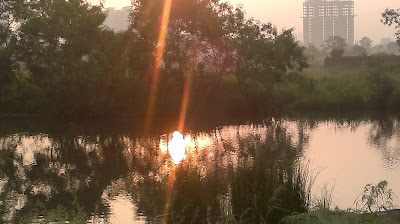Yet another Twitter storm! Me
thinks the twitterati outrages a bit too much and this time the outrage has
arisen due to the renaming of Aurangzeb Road to APJ Abdul Kalam road. Worthies
on Twitter, including Assadudin Owaisi, have jumped in to debate Aurangzeb and
his policies. I sincerely believe the funniest and most ill informed debates in
India happen about history and historical characters. Our ignorance of history
is profound and our belief in our great knowledge of history is “profounder”
Be that as it may, I have no
intention of either assailing Aurangzeb as an anti-Hindu mass murderer or eulogizing him as a
pious Pir. Enough ink has been spilt on his temple demolitions, his imposition
of the Jiziya, his unjust imposition of an ad valorem duty only on Hindu
traders and his extremely cruel torture and killing of Guru Tegh Bahadur and
some of his followers.
I want to speak about the man
himself. He lived a full life – he died at 90. What kind of person was he?
Well he was . . . He was a small
statured, large nosed, teetotaler chappie who slept very little and worked very
hard almost all through his life. And I suspect made his minions work as hard. He
held court daily, sometimes twice a day and set aside Wednesdays as Trail Days.
He was a stickler for detail and
had a phenomenal memory. The Italian physician Gemelli Careri who saw him in
1695, when Aurangzeb was almost 80, “admired to see him endorse the petitions
with his own hand, without spectacles, and by his cheerful smiling countenance
seem to be pleased with the employment.” Of course, Gemelli had no clue why he
was smiling but clearly our man was quite the bright-eyed workaholic.
Aurangzeb was a master
calligraphist and had a passion for reading, which he did right through his
life, in spite of his . . . er … um . . . rather busy schedule of killing
brothers, imprisoning Daddy, conquering territories, running after Shivaji (exhaustingly
unsuccessful running at that) and terrorizing thousands of others.
He was almost a linguist, being
the master of Arabic, Persian, Turki and wait for it . . . Hindi. According to Jadunath Sarkar, “… his
extensive correspondence proves his mastery over Persian poetry and Arabic
sacred literature.” Arabic sacred literature – I would have been shocked if he
did not have a command over it. But Poetry? Our Alamgir? Who knew?
The Fatwa-i-Alamgiri, an
exhaustive digest of Muslim Law, was put together under his patronage. Even
after his death the Fatwa-i-Alamgiri defined Islamic justice in India. I haven’t
been able to figure out till when it was used as a standard for Islamic justice
in India, but the fact that it continued to be used gives us an indication of
the thoroughness with which it was compiled.
The surprise about him is also
that he was supposedly a very personable man. Even as a prince, his tact,
wisdom and humility made the nobles of Shah Jahan’s court his friends. Of course
the immediate conclusion that one can come to is that he was doing this as he
was already planning to take the help of all these people when kicking his
brothers Shuja and Dara in the ass, but that would be wrong and unjust. Why is
that? That is so because these were the very same qualities that he displayed
even as an emperor.
Incidentally there are no scandalous
stories about his philandering ways. No deflowering of a 1000 virgins like his
great-grandfather Akbar. He had only
four wives as limited by Quranic injunction. Of them Dilras Banu (1657) and
Aurangabadi Mahal (1685) pre-deceased him. His third wife, Nawab Bai, led a
retired life in Delhi after 1660. His only companion was his 4th one
till his death. She was also very young. Just saying!
Like most rulers in medieval
India he was noted for his bravery and uncommon physical strength. Supposedly
at about 15 years of age he faced a furious elephant and subdued it. Declaring later
that death comes to all and it did not behove his brothers to act the way they
did.
Cool as a cucumber in battle and
a cunning tactician he gave quite a few examples of these in the innumerable
battles that he fought through his life.
On the eve of the Battle of Khajuha,
which was fought between Aurangzeb and his brother Shuja for the throne of
Delhi, Jaswant Singh who commanded Aurangzeb’s right-wing attacked the camp in
the dead of the night and left for Rajputana. Aurangzeb was unfazed, took the information
on board recalibrated his battle strategy and turned the tide in battle the
next day.
When his son, Prince Akbar
revolted against him and allied with the Rathor-Sisodia alliance, Smart Boy Aurangzeb
sent a false letter to his son “thanking him for carrying out their plan”. He ensured
that that letter fell in the hands of his enemies. Durga Das Rathor took one
look at this letter and off he went to check with Prince Akbar. Akbar was fast
asleep and DD Rathor was not allowed to meet him. This hardened his suspicion
and after kicking some butt in the camp Durga Das and the Rajputs went away to
Mewar. When Prince Akbar woke up in the morning, he had a camp but no soldiers.
Well almost. And the battle was over before it began. Aurangzeb 1 – 0 Prince Akbar.
Alamgir bhai never felt satisfied
without personally accomplishing the duties of the state. He clearly had the
capabilities but over time that made him over confident and also suspicious of
others, even his own sons. Efficiency deteriorated in the administration along
with his growing age. Remember he hit a 90?
Aurangzeb believed in orthodox
Sunni Islam. And having claimed the throne of Delhi against the liberal minded
Dara, whom he considered to be a heretic, he believed it to be his duty to
enforce Quranic law. He believed it was his destiny to convert his realm from
Dar-ul-harb to Dar-ul-islam. So he attacked . . . the Hindus, right? Er . . . only the Hindus? No, not at all. The Shias and
the Sufis faced the brunt of his orthodoxy too. The Bohra community from
Gujarat also suffered at his hands – for heresy!
According to the historian
Mohammed Yasin, “Aurangzeb’s recipe might be excellent from the point of view
of a Mujaddid (one who brings renewal to religion) . . . but he reduced the Muslim empire to a shadow.
. . “. That is absolutely true. He presided over the largest Moghul Empire but
also lay the foundation for the ultimate decline of the empire by bleeding it
due to his frequent campaigns.
He was a brilliant tactician but
he was neither a great strategist nor a statesman. He, in fact, understood the
futility of his life work when he wrote to his son Azam with poignant regret, ”The
days that have been spent except in austerities have left only regret behind
them. I have not at all done any (true) government of the realm or cherishing
of the peasantry. Life so valuable has gone away for nothing.”









